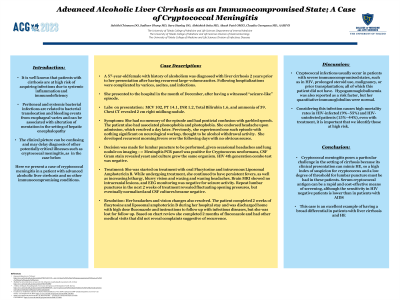Monday Poster Session
Category: Liver
P2463 - Advanced Alcoholic Liver Cirrhosis as an Immunocompromised State: A Case of Cryptococcal Meningitis
Monday, October 23, 2023
10:30 AM - 4:15 PM PT
Location: Exhibit Hall

Has Audio
- SC
Sahithi Chinnam, DO
University of Toledo
Toledo, Ohio
Presenting Author(s)
Sahithi Chinnam, DO1, Sudheer Dhoop, MD2, Sara Stanley, DO1, Abhishiek Setia, MD1, Akash Patel, MS3, Claudiu Georgescu, MD, AAHIVS1
1University of Toledo, Toledo, OH; 2University of Toledo Medical Center, Toledo, OH; 3Michigan State College of Osteopathic Medicine, Toledo, OH
Introduction: Patients with cirrhosis are at higher risk of acquiring infections. Immune dysfunction is due to systemic inflammation and immunodeficiency. Infection follows variceal bleeding, and leads to malnutrition and hepatic encephalopathy (HE). In patients with cirrhosis, neurologic complaints are frequently seen in the setting of HE, thus can delay diagnosis for other potentially critical illnesses such as cryptococcal meningitis.
Case Description/Methods: A 57-year-old female was diagnosed with liver cirrhosis due to alcohol use after having recurrent ascites. Later hospitalizations were complicated by varices and infections. She presented to the hospital after having a seizure-like episode. Labs on arrival include MCV 102, PT 14.1, INR 1.2, Total Bilirubin 1.6, and ammonia of 39. She had no memory of the episode, and had postictal confusion with garbled speech, and associated phono/photophobia. Headache was present on admission, which resolved quickly. Previous episode had unrevealing medical workup, thought to be alcohol withdrawal. Chest CT revealed 2 cm right mid-lung nodule. She developed morning fevers, and lumbar puncture was done. Meningitis panel and gram stain both revealed Cryptococcus Neoformans. She was started on Flucytosine and Amphotericin B. While undergoing treatment, she continued to have fevers with increasing lethargy, blurry vision and headaches. Brain MRI and EEG monitoring were unremarkable. Repeat LP was done, and ICP measurement was 33 mmH2O. Repeat puncture the following day measured at 15 mm H2O. Her headaches and vision changes resolved. She completed 2 weeks of Amphotericin B, and was discharged with high dose fluconazole.
Discussion: Cryptococcal infections usually occur in severe immunocompromised states; in HIV, prolonged steroid use, malignancy, or transplantation. Hypo-gammaglobulinemia was another reported factor, but her quantitative immunoglobulins were normal. This infection causes high mortality rates in HIV-infected and HIV-uninfected patients, even with treatment. It is important to identify those at high risk. Cryptococcal meningitis poses a challenge in the setting of cirrhosis because clinical presentation mimics HE, so a high index of suspicion for Cryptococcus and a low degree of threshold for LP must be had. Serum cryptococcal antigen can be a rapid and cheap screening tool, although the sensitivity in HIV negative patients is lower than in AIDS. This case is an excellent example of having a broad differential in patients with cirrhosis and HE.
Disclosures:
Sahithi Chinnam, DO1, Sudheer Dhoop, MD2, Sara Stanley, DO1, Abhishiek Setia, MD1, Akash Patel, MS3, Claudiu Georgescu, MD, AAHIVS1. P2463 - Advanced Alcoholic Liver Cirrhosis as an Immunocompromised State: A Case of Cryptococcal Meningitis, ACG 2023 Annual Scientific Meeting Abstracts. Vancouver, BC, Canada: American College of Gastroenterology.
1University of Toledo, Toledo, OH; 2University of Toledo Medical Center, Toledo, OH; 3Michigan State College of Osteopathic Medicine, Toledo, OH
Introduction: Patients with cirrhosis are at higher risk of acquiring infections. Immune dysfunction is due to systemic inflammation and immunodeficiency. Infection follows variceal bleeding, and leads to malnutrition and hepatic encephalopathy (HE). In patients with cirrhosis, neurologic complaints are frequently seen in the setting of HE, thus can delay diagnosis for other potentially critical illnesses such as cryptococcal meningitis.
Case Description/Methods: A 57-year-old female was diagnosed with liver cirrhosis due to alcohol use after having recurrent ascites. Later hospitalizations were complicated by varices and infections. She presented to the hospital after having a seizure-like episode. Labs on arrival include MCV 102, PT 14.1, INR 1.2, Total Bilirubin 1.6, and ammonia of 39. She had no memory of the episode, and had postictal confusion with garbled speech, and associated phono/photophobia. Headache was present on admission, which resolved quickly. Previous episode had unrevealing medical workup, thought to be alcohol withdrawal. Chest CT revealed 2 cm right mid-lung nodule. She developed morning fevers, and lumbar puncture was done. Meningitis panel and gram stain both revealed Cryptococcus Neoformans. She was started on Flucytosine and Amphotericin B. While undergoing treatment, she continued to have fevers with increasing lethargy, blurry vision and headaches. Brain MRI and EEG monitoring were unremarkable. Repeat LP was done, and ICP measurement was 33 mmH2O. Repeat puncture the following day measured at 15 mm H2O. Her headaches and vision changes resolved. She completed 2 weeks of Amphotericin B, and was discharged with high dose fluconazole.
Discussion: Cryptococcal infections usually occur in severe immunocompromised states; in HIV, prolonged steroid use, malignancy, or transplantation. Hypo-gammaglobulinemia was another reported factor, but her quantitative immunoglobulins were normal. This infection causes high mortality rates in HIV-infected and HIV-uninfected patients, even with treatment. It is important to identify those at high risk. Cryptococcal meningitis poses a challenge in the setting of cirrhosis because clinical presentation mimics HE, so a high index of suspicion for Cryptococcus and a low degree of threshold for LP must be had. Serum cryptococcal antigen can be a rapid and cheap screening tool, although the sensitivity in HIV negative patients is lower than in AIDS. This case is an excellent example of having a broad differential in patients with cirrhosis and HE.
Disclosures:
Sahithi Chinnam indicated no relevant financial relationships.
Sudheer Dhoop indicated no relevant financial relationships.
Sara Stanley indicated no relevant financial relationships.
Abhishiek Setia indicated no relevant financial relationships.
Akash Patel indicated no relevant financial relationships.
Claudiu Georgescu indicated no relevant financial relationships.
Sahithi Chinnam, DO1, Sudheer Dhoop, MD2, Sara Stanley, DO1, Abhishiek Setia, MD1, Akash Patel, MS3, Claudiu Georgescu, MD, AAHIVS1. P2463 - Advanced Alcoholic Liver Cirrhosis as an Immunocompromised State: A Case of Cryptococcal Meningitis, ACG 2023 Annual Scientific Meeting Abstracts. Vancouver, BC, Canada: American College of Gastroenterology.
